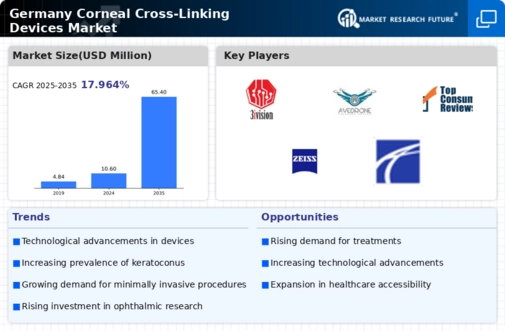Growing Awareness and Education
The rise in awareness and educational initiatives regarding corneal diseases is a significant driver for the corneal cross-linking-devices market in Germany. Various organizations and healthcare providers are actively promoting awareness campaigns about keratoconus and the benefits of cross-linking treatments. This educational push is likely to lead to earlier diagnosis and increased patient inquiries about treatment options. As patients become more informed, the demand for corneal cross-linking procedures is expected to rise. Market analysts suggest that this trend could result in a 15% increase in patient consultations for cross-linking treatments over the next few years, thereby positively impacting the market.
Regulatory Approvals and Support
Regulatory bodies in Germany are increasingly supportive of innovative medical devices, including those used in the corneal cross-linking-devices market. The streamlined approval processes for new technologies encourage manufacturers to introduce advanced products to the market. This regulatory environment fosters competition and innovation, which can lead to improved treatment options for patients. As new devices receive approval, they are likely to enhance the overall market landscape, potentially increasing market size by €30 million by 2028. The proactive stance of regulatory agencies not only benefits manufacturers but also ensures that patients have access to the latest and most effective treatments available.
Rising Prevalence of Keratoconus
The increasing incidence of keratoconus in Germany is a primary driver for the corneal cross-linking-devices market. Studies indicate that keratoconus affects approximately 1 in 2,000 individuals, leading to a growing demand for effective treatment options. As awareness of this condition rises, more patients seek interventions that can halt disease progression. The corneal cross-linking procedure has emerged as a preferred treatment, as it strengthens corneal tissue and improves visual acuity. This trend is likely to boost the market, with projections suggesting a compound annual growth rate (CAGR) of around 10% over the next five years. Consequently, the healthcare sector is expected to invest more in advanced cross-linking technologies to cater to this rising patient population.
Increasing Healthcare Expenditure
Germany's commitment to healthcare spending is a crucial driver for the corneal cross-linking-devices market. The government has consistently increased its healthcare budget, which is projected to reach €500 billion by 2026. This financial support facilitates the adoption of advanced medical technologies, including corneal cross-linking devices. As hospitals and clinics receive more funding, they are more likely to invest in state-of-the-art equipment and training for healthcare professionals. This trend is expected to enhance the availability of cross-linking procedures, thereby expanding the market. Furthermore, increased healthcare expenditure may lead to improved patient access to these treatments, further stimulating demand.
Technological Innovations in Treatment
Technological advancements in corneal cross-linking devices are significantly influencing the market landscape in Germany. Innovations such as accelerated cross-linking techniques and the development of new riboflavin solutions enhance the efficacy and safety of the procedure. These advancements not only improve patient outcomes but also reduce treatment times, making the procedure more appealing to both patients and healthcare providers. The introduction of new devices is expected to drive market growth, with estimates indicating a potential increase in market value by €50 million by 2027. As these technologies become more widely adopted, they are likely to reshape the competitive dynamics within the corneal cross-linking-devices market.
















Leave a Comment